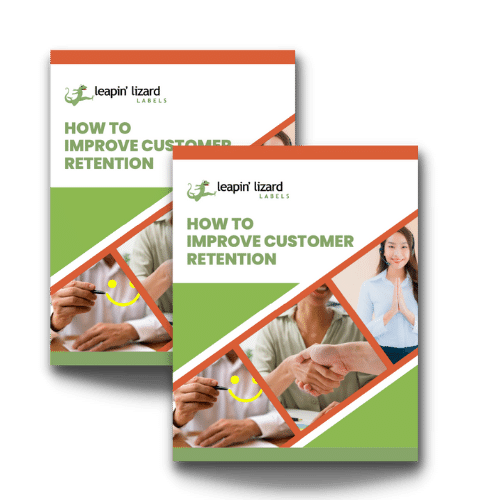Imagine this (if you can): You didn’t really want to stop at the store on your way home after a long Monday at work; the 5 o’clock traffic is already awful. But here you are, just having parked in front of your local market. You can’t possibly rub the almost-bare plastic of your deodorant tube on your armpits even one more day. It is time, and you’re almost out of coffee, too.
You’re tired, annoyed at the necessity of having to shop when you’d rather already be in jammies watching Netflix, so you promise yourself you’ll be quick. And it is quick.
Your trip inside the store takes only ten minutes. You’re back in your car with your toiletries and bean juice in a jiff, and with lunches for the week to boot!
As you wove through the aisles of the store, you gravitated toward brands you already know and love, and you easily found your favorite bagels and toothpaste. Why? Because you stare at the labels on your bathroom and kitchen counters every day!
What made that trip so painless, so simple? It’s because your favorite brands have embraced a core tenant of marketing: label consistency.
What is Label Consistency, and Why Should Your Business Care?
As you may have already guessed, label consistency is a form of branding, and it’s how companies establish credibility in their industry.
You didn’t need to stand there and think about which tube of deodorant to purchase; you know exactly what your aluminum-free, eucalyptus-scented deodorant looks like. It’s looked like that since you started buying it years ago. The same goes for your morning bagels, your pre-made cold-brew coffee. You could pick out those products with your eyes closed (almost).
And you’re not alone. 60% of consumers prefer to buy from brands they’re familiar with. It makes sense, this desire for consistency. Consistency in your branding, labeling, and packaging tells your customers you still have the same product and personality over time. It creates a relationship between you and your consumer.
Why You Need Brand and Label Consistency
Having great label consistency is fairly synonymous with brand consistency. Label consistency doesn’t quite mean that every single one of your products has the exact same logo or is in identical packaging. If you sell natural deodorant and toothpaste, the mechanics of that wouldn’t work well, anyway (just try to picture applying toothpaste to your toothbrush out of a deodorant-sized tube).
Having consistent packaging and labeling for your brand means you stick to your brand’s unique personality, which builds your brand’s identity over time and a sense of trust between you and your consumer. This makes your brand feel familiar to your consumer and makes it more likely to attract the attention of prospective customers.
The Advantages of Consistent Labeling
Once you begin thinking of your labeling and branding as a communication between you and your ideal consumer, you’ll realize how simple it can be to tell your story and connect with those customers, whether they see your labels in social media ads or on the shelves at the store.
Furthermore, your label–the way you present your product to the world–has an enormous effect on buyer’s decision making in the store. In a study conducted by the University of Pennsylvania, researchers found that 70% of people make decisions on what to buy right there in the store aisles. The same researchers also found that only 1 in 10 shoppers decide to switch brands while in a store, which means keeping your labeling consistent can benefit you time and time again.
There is an enormous opportunity to influence buying decisions simply by having people recognize your product. That return buyer may not have had your product on their shopping list, but seeing your familiar brand made them remember they’re almost out of their favorite salad dressing.
If you deliver a great product after you’ve established recognition and gotten a customer to purchase your product? They’ll trust you even more and will likely become loyal customers.
# Tips for Keeping Your Labels Consistent
Alright, you’re sold! You now understand how powerful consistent product labeling is and how synonymous it is with great branding. You want to be that brand your customers love and trust. Here’s how to do it:
- Create a unique and memorable “look”
Your labeling should be distinct and specific to your brand. You want to stand out from the crowd of the other 253 deodorant options (okay, maybe there’s not that many, but it sure feels like it sometimes).. - Use style to mirror your brand personality
Your labeling should reflect your brand’s personality. Choose a design that speaks to you and the emotions or vibe you want your consumers to get from your product. Does your brand personality mesh better with more vintage-inspired, classic packaging? Deep, bold colors? Playful drawings? - Stick to the same primary font
Fonts can do a lot. There’s a reason your college professor required all your essays to be in Times New Roman–and it's the same reason why you’d never send an email to a coworker about an important issue in Comic Sans. Choose a font like you chose your style: pick whatever is readable and best mirror’s your style. - Choose colors that align with your goals
Color psychology in marketing is a fascinating topic. Ever wonder why pretty much all fast food chains use variations of yellow and red in their logos? Color Psychology reports that red has been shown to evoke strong emotions and is shown to increase appetite (weird, isn’t it?), and yellow encourages communication and cheer. Do a bit of research into how different colors affect buyers to determine not just what your label will look like but how your label will make people feel. - Research your ideal consumer’s behavior and act on it
Not every industry can cater to every customer, so conduct some consumer behavior research and figure out more about your buyer. What are their pain points? If you’re selling that natural eucalyptus-scented deodorant, there’s a good chance your ideal consumer is environmentally conscious and would choose your product because your packaging is made from recycled material and uses 25% less plastic than your competitor. - Find a great label printer
Once you have consistent labels designed for your ideal customer ready to go, you’ll need a trusted printer. Check out Leapin’ Lizard Labels for all your label printing needs!





